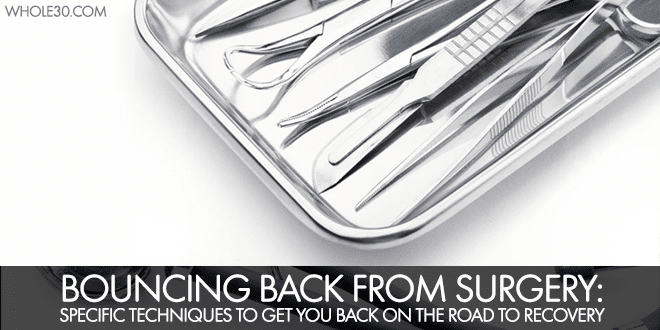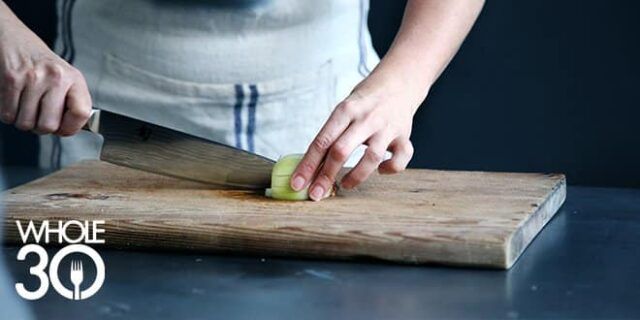By Luc Readinger, MD and Melissa Urban (part of the Talk to your Doc series)
In spite of healthy living (eating well, participating in regular physical activity, getting adequate sleep, and managing stress), health crises can still occur, and sometimes an injury or medical condition may necessitate the use of steel to heal. If you ever find yourself having to undergo the knife at the hands of a skilled surgeon, use these techniques to augment your recovery process.
Note: Although every surgery is different, these ideas can be generally applied to any surgical procedure. As always, however, consult with your surgeon or medical doctor before undertaking these recommendations (or any recommendations you find on the internet).
Pre-Op: Optimize health
Being in a robust state of health going into surgery will maximize your chances for a speedy recovery afterward. How do you optimize health? Lots of thoughts, observations, trials (and errors), millions of words, and a gazillion books have been documented about this. Start with a Whole30 program as a solid basis for considering your own state of health, and as a template to optimize your health and wellbeing.
Specific Nutrition
Making sure you’re getting adequate amounts of calories and protein will help with surgical wound healing. If you’re already eating a healthy diet rich in a wide variety of micronutrients, you will heal optimally. However, there are some supplements that can assist in the healing process. Think of them as an insurance policy, however—by no means will they take the place of a nutritionally robust diet.
Vitamins A, C, and E, and zinc all play important roles in healing. If you have a scheduled surgical procedure coming up, it may be worthwhile to temporarily supplement your diet with an ACE supplement (vitamins A, C, and E together in a single supplement) and zinc.
A typical ACE supplement will contain 5,000-10,000 IU vitamin A (provided through beta carotene), 250-500 mg vitamin C, and 200-400 IU vitamin E. These are safe, recommended dosages for adult non-smokers.* (Sometimes ACE supplements may be labeled as “ACES” and contain selenium as well—this is a perfectly fine addition.) Zinc is generally safely tolerated at doses up to 40 mg daily for adults.
If you take an omega-3 fatty acid supplement (like moderate to high-dose fish oil), stop taking your liquid or pills 10 days before surgery. These supplements have a blood thinning effect, and may make clotting more difficult. If your surgery is of an urgent nature, do your best to let your health care team know your current supplement(s) and dosage(s) before you are wheeled into the operating room.
*Studies have shown an increased risk of lung cancer in adults who smoke tobacco and take supplemental beta carotene.
Homeopathy
Homeopathy is a branch of medicine founded on the theory of “like cures like.” It seeks to resolve illness by giving minute doses of a substance that would normally induce the same symptoms as the cause of the illness or injury. While the doses of the substances given are so dilute that no particles of the substance are left in the remedy, these medicines sometimes have clinical effects that are quite powerful. While not widely embraced by mainstream medicine in today’s day and age (homeopathy was not mentioned over the course of my allopathic medical education), homeopathy was quite commonly practiced by U.S. doctors in the 19th century.
Arnica montana is a very common homeopathic remedy that you can find at your local health store and is used for injuries and trauma, including surgery. (Yes, getting cut with a scalpel is both an injury and traumatic). Arnica is reported to help you recover from surgery by reducing your swelling and bruising and increasing blood flow to the tissue. Adults should take a dose of 200C, five pellets dissolved under your tongue two hours before surgery. Follow this up by taking the same dose daily for the next 2 weeks. (The most widely available brand in this dosage is Borion, available on Amazon for about $10.)
A note with respect to topically-applied arnica: never apply arnica directly to a surgical incision, cut, or any open wound, as this will cause irritation and blistering. Please avoid topical Arnica cream, gel, and ointment preparations in the post-operative setting.
Post-Op: Recovery
These suggestions are designed to work with your surgeon’s recommendations. Always consult your health care team before making any decisions about your post-surgical recovery.
Bowel function
Surgery will cause some dysregulation of your bowels, even if performed at a site other than your abdomen. Pain medications and general anesthesia both have the effect of slowing the digestive tract. If your surgery is on the gastrointestinal tract, this serves as a double whammy, interrupting normal digestive function even more. While the digestive slowdown is temporary, it can be very uncomfortable.
First, stop taking opioid-based pain medication (morphine, oxycodone, hydrocodone, etc.) as soon as you are comfortable and your doctor says it’s okay. The sooner you are able to come off these medications, the better chance you’ll have of restoring normal, healthy bowel function naturally. If pain relief is necessary, non-opioid medications are your best option, with the exception of NSAIDs (like ibuprofen). NSAIDS, or nonsteroidal anti-inflammatory drugs, have been shown to increase intestinal permeability—and leaky gut is not something you want to promote during this time of healing.
Your doctors and nurses will closely monitor oral intake of food and liquids (and your digestive output), and may offer medications like stool softeners to get things moving again. However, there are a few things you can do to help get things moving on your own.
First, as soon as you’re able to take liquids, start hydrating. Get some sips of liquid in every hour, even if you’re still getting IV fluids. You can also request prune juice, famous for helping people have bowel movements. Start with a small dose (8 ounces of prune juice) followed by water over the next few hours. Increase your input slowly as needed. (Once you’re able to advance to solid foods, you can eat a few prunes as well.)
Magnesium is also a natural way to help speed things up, particularly when taken in a powdered citrate form. If your medical team approves (and isn’t already prescribing this for you!), try 2 teaspoons of Original Flavor Natural Calm mixed well into water. (Wait until it stops fizzing before consuming.) Wait a few hours, then if needed, try another teaspoon. Repeat until the desired effect is achieved. Be careful with this strategy if you have kidney disease, as your body may process magnesium differently than those who have normal-functioning kidneys.
Finally, getting up and moving around (see below) as soon as your doctor says you are able will help you restore healthy digestive function and eliminate trapped gas; a particularly uncomfortable condition that goes hand-in-hand with abdominal surgery. If you have had bowel surgery, restoration of normal bowel function may take longer. Be patient and don’t rush things. While return of your regular digestive function may be delayed, this is part of your body’s natural healing response to your gastrointestinal tract being “injured” via your surgery.
Antibiotics
Many times antibiotics will be prescribed in conjunction with surgery. This may be a one or two-time dose, or could involve a longer course. Any antibiotic you take is going to have an effect on your gastrointestinal bacteria (also referred to as normal flora, or more generally, the microbiome).
Large amounts of bacteria, certain species in particular, live in your intestines. This is normal and healthy; your gut bacteria aid your immune system and take up space that would otherwise be occupied by “bad” bacteria. When your regular, healthy gut bacteria are thrown out of balance, you will experience gastrointestinal-specific symptoms: excessive gas, abdominal bloating, diarrhea, and/or constipation. A bacterial imbalance can even cause systemic symptoms such as fatigue, generalized aches, skin rashes and cognitive deficits. Symptoms can persist long after the course of antibiotics has been completed, until the imbalance is restored.
You can use probiotics to help mitigate the disruption caused by antibiotics. Probiotics are healthy bacteria—the kinds normally found your intestine’s normal flora. One specific strain you want take when you’re on antibiotics is Saccharomyces boulardii. This specific strain of yeast has been shown to prevent Clostridium difficile (C. diff) infections, an especially nasty condition. An adult dose is a total of 500 mg or 5-10 billion CFUs (colonyforming units) per day; if you’re otherwise healthy, take this for two weeks. One brand that covers all your bases well is Klaire Labs ABX Support, sometimes available on Amazon for about $50. (Yes, it’s expensive, but the “probiotics” you’ll buy off the shelf at your local drug store aren’t actually helping your cause.)
In addition to this, you should also take a good quality broad spectrum probiotic containing Lactobacillus and Bifidobacterium species over the course of 4 weeks, at a dose of 40-50 billion CFUs daily. A high quality probiotic should specify the guaranteed number of CFU’s present in the product on the expiration date. A soil-based probiotic can also round out your bacterial balance post-surgery. (For more, listen to this Do the Thing podcast, “Fix Your Gut.”)
Note, it is very important to take probiotics at least 2 to 3 hours apart from any antibiotic dose so the antibiotic does not kill the probiotic you are trying to replace during the digestive process. Take them with food.
Movement
Appropriate movement helps bring blood flow to an injured area, aiding the healing process. In addition, movement can provide gentle stimulation to your internal organs, helping restore healthy bowel function and release trapped gas.
Approach healing from surgery as an exercise in active recovery. Moving around after your procedure (within the recommendations of your surgeon) can help speed up the recovery process, but it’s a balancing act, so pay attention and work closely with your doctors and nurses at this stage. Discomfort associated with movement after surgery can be expected, but therapeutic movement shouldn’t induce pain. Pain is your body’s way of telling you you’re doing too much, and for you to back off so healing can take place.
You may have physical therapists involved in your care to help guide you. If not, simply getting up and walking every few hours as you are able will be beneficial.
Breathing
After a surgical procedure, you run the risk of a partial lung collapse if you lie in bed for a prolonged period and breathe shallowly. To help keep your lungs open after surgery, take ten deep breaths every hour. (Your doctor or nurse will likely provide you with instruction, and maybe a device, to aid you with this exercise.) This may be uncomfortable depending on the type of surgery you had, but it’s important to keep your lungs clear and open.
If you can, think of these as cleansing, relaxing breaths. Deep breaths provide gentle, intermittent compression against your abdominal organs and can be thought of as another form of movement and as gentle stimulation to your gastrointestinal tract. If done in a meditative way, it can help mitigate some of the physical and psychological stress you’re going through in association with the procedure.
Diet
Hospitals aren’t exactly known for their Whole30-friendly menus, and chances are the first foods you’ll be offered aren’t going to fit in your healthy eating plan. Ironically, eating “typical” hospital food (things like sugary dairy-based puddings, high fructose corn syrup-based “nutritional” shakes, grain-based cereals, and other foods that you already know from your Whole30 don’t make you more healthy) may actually make your digestion worse instead of better.
If possible, have friends or family bring you in healthy foods, making sure they fit your surgeon’s recommendations. If you’re on a liquid diet, there’s nothing better than homemade bone broth, homemade gelatin or “gummies” (leaving out the sugar), coconut water (for variety), or organic drinkable vegetables. Once you progress to soft solids, have them bring you some Whole30-compatible soups, mashed potatoes with ghee, soft fruits like bananas, or scrambled eggs. Finally, once you’re back to eating solids, keep it as close to Whole30 as you can, avoiding added sugar where possible.
If you don’t have the ability to have food brought in from the outside, speak with your nurse or dietician and specifically request gluten-free, dairy-free meal offerings. (Include any other foods or food groups that you know specifically aren’t good for you.) Follow our Dining Recommendations here; be polite but firm, thank everyone for accommodating your wishes, and do the best you can to work around a less-than-ideal situation.
Get Professional Help
Finally, post-surgery might be the right time to seek the help and support of a qualified Functional Medicine practitioner. He or she can help you balance your gut bacterial population, evaluate any post-operative symptoms or concerns, and treat any longer-term health effects of your surgery (such as minimizing adhesions from abdominal surgery).
If you have time, schedule an appointment with a functional medicine provider for the week after you return home from the hospital, to evaluate where you are in the healing process and see if there are additional tests or treatments that will compliment your surgical team’s recommendations.
Prevention is the Best Medicine
Ideally, your healthy diet and lifestyle will keep you off the operating table; in fact, it is my hope you’ll never need to use these tips. But should injury, accident, or a health condition lead you to surgery, use these tips (along with the recommendations of your surgical and health care team) to help you recover faster, more easily, and with fewer long-term effects.
Luc Readinger is a family functional integrative medicine physician practicing in Wisconsin.He occasionally posts something on his website: lucreadinger.com.
Melissa Urban is the co-founder and CEO of the Whole30 program and a 6-time New York Times bestselling author. She recently had surgery for a ruptured appendix, which prompted the collaboration for this article.
Some links in this post are affiliate links, meaning we make a small commission from purchases made via these links. Thank you for supporting our Whole30 partners.
















